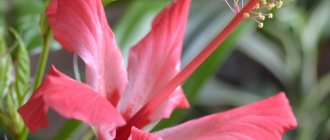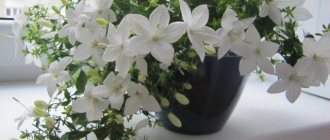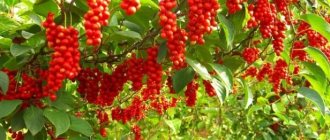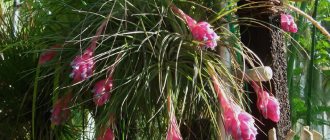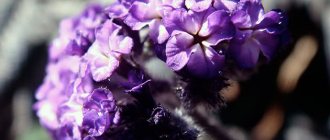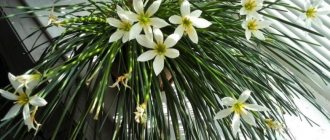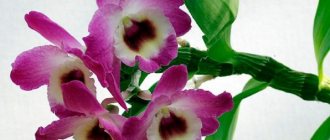Hibiscus is a flower that has become a symbol of art, resilience and humble beauty. Following one fading bud, a new one immediately opens - and so on all season. In the East, the flower is used in cooking and medicine, and they also make aromatic tea from it. We tell you how to grow hibiscus yourself and what they are like!
general information
Hibiscus is the same hibiscus tea, the national symbol of Malaysia and the Chinese rose in one bottle. It belongs to the Malvaceae family and some varieties are even confused with ordinary mallows. Hibiscus flowers are large, colorful, graceful and have long, colorful corollas.
Hibiscus was grown in European botanical gardens back in the eighteenth century, and since then its popularity has not fallen. The diameter of the flowers reaches 16, and sometimes over 20 cm. The shrubs live up to thirty years and, once mature, cause virtually no trouble.
Hibiscus flowering lasts only a few days, but this is fully compensated by its lushness. If you properly care for the plant, it will grow buds again and again. In warm latitudes, most varieties are evergreen perennials that bloom all year round.
Pruning and feeding the plant
Feeding and pruning hibiscus is the most important stage in caring for the plant. It must be done immediately after magnificent flowers appear on the young shoots of the plant. It is also necessary to cut out shoots growing parallel to the trunk. Branches that grow inside the tree also need to be removed. You can form a hibiscus in the form of a standard tree that is now fashionable. In early spring, hibiscus shoots should be pinched, including very young ones. And hibiscus tolerates pruning well at any time of the year.
In the spring and summer, hibiscus will gratefully respond to weekly potassium-phosphorus feeding. You should refrain from nitrogen-containing fertilizers - this indoor flower does not “celebrate” them much. Before fertilizing, do not forget to thoroughly water the earthen ball so as not to burn the roots of the plant. Hibiscus will also be grateful for foliar feeding.
Hibiscus species
Hibiscus is found in cultivation in almost all possible forms: annuals and perennials, herbaceous plants, shrubs and trees, evergreen and deciduous. According to various estimates and studies, there are up to 300 varieties in nature.
Hybrid hibiscus
This is the most popular variety in our latitudes, which is grown in gardens and apartments. From his ancestors he inherited frost resistance and large inflorescences up to 25 cm in diameter. By winter, the stems of hybrid hibiscus die off completely, but the powerful root system easily survives the cold.
Syrian hibiscus
A large and tall shrub can grow up to as much as 6 meters, remaining beautiful and tidy. Smooth long branches are crowned with large single flowers of all shades of pink and red. Syrian hibiscus develops slowly, but the process can be accelerated by systematic moderate watering.
Swamp Hibiscus
As the name suggests, this species is very fond of humidity and bodies of water - a lake or stream nearby. Swamp hibiscus is very elegant, blooms for a long time and pleases with a variety of shades. It is frost-resistant and tolerates winters even in fairly harsh latitudes - down to -25 degrees.
Spread hibiscus
An interesting Australian variety attracts with its unusual structure of stems and leaves. The shoots of the splayed hibiscus seem to be prickly, and the same goes for the fuzzy calyx of the flowers. In nature, the bush grows up to 5 m, but in cultivation it stretches up to 3. The branches fancifully diverge in different directions - they spread out at an angle and upward.
Hibiscus Rosanel
This variety is also called Chinese rose because its bushes are very reminiscent of rose bushes. Woody shoots can turn into real powerful trunks over the years. Bell flowers reach 15 cm in diameter and most often grow solitary.
Sour hibiscus
An unusual African variety with red maple-shaped leaves is the same hibiscus from which tea is made and widely consumed as food. Unfortunately, in our latitudes it is grown only as an annual, because it does not tolerate frosts below -8 degrees. Sour hibiscus flowers are small, but very beautiful and colorful.
Variegated hibiscus
An interesting feature of this variety is the presence of completely different leaves on one stem. They seem to be torn and unevenly jagged, of completely different sizes and densely fleecy on the reverse side. The inflorescences of their pale yellow buds with a purple center seem to be directed downwards.
Hibiscus Hugel
Another bizarre Australian variety is nicknamed lilac hibiscus for the characteristic color of its buds. The bush is densely branched and lushly covered with bright green leaves with fleecy segmented plates. The shape of the buds looks interesting, each petal covering the previous one.
Hibiscus Arnotti
This variety is actively used in medicine and pharmaceuticals, but is also grown as an ornamental annual. In nature, it grows on the Hawaiian Islands, and there it is an evergreen perennial shrub with straight stems that can sometimes grow up to 10 m. You can grow Arnotti hibiscus in the garden, but take the rhizome indoors for the winter.
Reproduction
Indoor hibiscus is propagated by seeds and cuttings. Both methods give good results and do not require much effort.
Propagation by seeds
After the flower withers, seeds are formed in it, with the help of which the hibiscus reproduces. To grow a plant from seeds, they must be removed from the bud and soaked overnight in a growth stimulator, then placed in a weak solution of manganese for several hours to degrease.
The prepared planting material should be placed in wet gauze until sprouts appear. Seeds with sprouts must be placed in the ground. The plant will germinate in a couple of weeks. Flowering will begin in 3-4 years.
Note! A Chinese rose obtained from seeds may differ in its qualities from the parent tree.
Propagation by cuttings
Propagation by cuttings allows you to quickly obtain a flowering plant. Only an adult plant can be cut; young branches with at least 3 internodes are used as layering.
Rooting of the cuttings in the ground takes up to 2 months. To do this, it is necessary to remove the young branch with an oblique cut and place it in moist soil. To speed up the process, cover the cuttings with cellophane.
You can also root the cuttings in water. To do this, cut branches are placed in clean water. Cuttings are planted in the ground when a pronounced root system appears. Cuttings cut at the end of the year can begin flowering by summer.
Hibiscus care
Many ornamental hibiscus varieties can only be grown as annuals. But now there are also frost-resistant hybrids, and most of them are among terry varieties. In general, warmth and sun are the main points when caring for hibiscus.
Temperature
Most hibiscus varieties come from tropical and subtropical latitudes, so the ideal temperature for them is 20-25 degrees. Frost-resistant varieties can be mulched for the winter and left in the ground, but the rest will have to be dug up and taken indoors. For indoor hibiscus, you can lower the temperature to +12 degrees for the winter so that the buds form better next year.
Lighting
Hibiscus loves the sun and sunny areas - and this is also directly related to its natural habitat. If it does not have enough light, it will bloom poorly or the buds will not bloom at all. This applies to both garden shrubs and small indoor flowerpots.
Watering
Hibiscus loves water very much, so they don’t stop watering even in winter - they just reduce the frequency. It is important that the earthen ball does not dry out completely, otherwise the flower may die. In the heat of summer, sometimes you have to water your hibiscus generously every day.
The soil
The same soil that is used for roses is ideal for hibiscus: fertile, light and moisture-permeable. For indoor plants or planting seedlings, mix turf with leaf soil, sand and humus. You can use ready-made store-bought mixtures for ornamental plants.
Fertilizers and fertilizing
During intensive growth, hibiscus requires regular feeding, and nutritious complex fertilizers are best suited. But do not use universal mixtures for flowering plants, because they contain too much phosphorus for hibiscus. But you can safely add more potassium and magnesium!
Transplantation and propagation
Hibiscus is propagated by seeds, grafting or simple division of the bush. All three methods are very simple and effective, so even a beginner can easily handle them. Seedlings are planted in open ground towards the end of spring, when warm weather has already settled.
Cuttings for propagation are cut in the summer at the height of the season with 2-3 internodes at once. Be sure to treat them with a growth stimulator so that they take root better and faster. The process will take about a month, and during this time, bottom heating will not be amiss.
If you need to propagate hibiscus by seeds, then they are sown in containers from January to March. Hibiscus is germinated under glass at a temperature of about 26 degrees, so heating may be necessary. You can plant seedlings in separate pots immediately after the first leaves appear.
Trimming
After planting or after spring, you need to carefully and carefully remove all weak and damaged shoots. To stimulate flowering in the spring, all last year's growth is shortened by about a third. If the bush begins to grow too untidy and unevenly, carry out radical anti-aging pruning.
For the first couple of years, perennial garden hibiscus should be regularly and radically pruned if you want to get a large, lush bush in the future. Using the same principle, to form a standard tree, the side branching shoots are cut off and the main trunk is left. If the desired crown shape has already been achieved, a small amount of maintenance pruning will suffice in the future.
How to care?
Care at home is very simple: hibiscus needs good diffused lighting and watering.
Location and lighting
Is it possible to keep a flower at home? Yes, sure. It is recommended to place it on a western or eastern window sill, but shade it with curtains, since it will not tolerate direct sunlight. This culture prefers diffused lighting.
If the apartment has a loggia or balcony, then you can put a flower there in the summer, but first shade it.
Advice! If the hibiscus is not well lit or in complete shade, it will not bloom.
Temperature
The plant loves warmth and does not tolerate sudden changes in air temperature.
In winter, ensure the air temperature in the apartment is +14-16°C, and the rest of the time - +18-22°C.
Advice! In winter, do not allow the air temperature in the room to be below 10°C, otherwise the plant will begin to shed its leaves.
Air humidity
The flower does not require excessive moisture. You can spray it sometimes.
Watering
In spring, summer and autumn, water it regularly and abundantly with warm, well-settled water. Water it when the top layer of soil dries out.
In winter, watering should be reduced, 3 days after the surface of the soil in the pot has dried.
Attention! Water the plant very carefully in the first month after purchase, otherwise it will die.
The soil
Flowers require a lot of organic matter and minerals. It is necessary that the soil is light and has good water permeability. It must contain humus. According to acid characteristics, the soil should be neutral (pH=6). If you want to prepare the substrate yourself, then mix: 1 part each of humus and sand and 2 parts of turf soil.
The pot must have holes. Pour small pebbles, expanded clay, broken brick, crushed polystyrene foam onto the bottom, and only then add the substrate.
Feeding and fertilizers
The plant is fed when it is actively growing, this is spring and summer. They are fed with solutions of mineral fertilizers that contain nitrogen. They make flowering last longer. Feed once a month. In winter, this is done with potassium and phosphorus, but the amount of fertilizer is reduced. Feed after abundant watering.
Transfer
The culture of the house is growing quite actively and a tree is growing, covered with buds.
Young plants need to be replanted annually , and mature trees - once every 2-3 years. If there are no insects in the soil, then you can remove a layer of soil of about 5 cm and add a new substrate.
Replant by transferring the flower into a wider and deeper pot.
Trimming
The crown is formed by pruning.
How to prune, at what time?
It is necessary to form the crown by removing excess leaves immediately after transplantation; this stimulates the growth of new branches, which will then produce buds. After transplantation, the stem is cut down to the bud so that approximately 15 cm remains from the surface of the ground to the top.
When young shoots begin to grow, the most powerful ones are left and the stunted ones are cut off.
It is best to prune in May, as the buds grow exclusively on the current year's branches.
Attention! Hibiscus can grow from a single rhizome, even if the stem and foliage are cut off.
Pest and disease control
A sticky coating on the leaves most often indicates the appearance of aphids, and small cobwebs on the back side are a sure sign of a mite. Hibiscus is also eaten by whiteflies and scale insects, and scale insects like to settle on the branches. It is very important to remove all faded buds in a timely manner, because gall midges lay eggs in them over time.
The most common disease of hibiscus is non-infectious and infectious chlorosis. The first appears due to improper care and imbalance of beneficial elements, and the second due to a fungus or virus. Another common consequence of fungal infections is vascular wilt. In this case, you need to urgently cut off the diseased branches, including the healthy part, and treat them with fungicides.
Description of the appearance of the plant
Hibiscus has leaves with long petioles, cut along the edges. Most varieties have large, graceful flowers of bright, juicy color.
The fruits form a capsule, which breaks into 5 parts and includes a large number of seeds covered with down or fibrous threads; in some species the seeds are smooth.
Hibiscus – photo
The graceful beauty of hibiscus will not leave anyone indifferent. Just look how good they are in our selection of photos!

